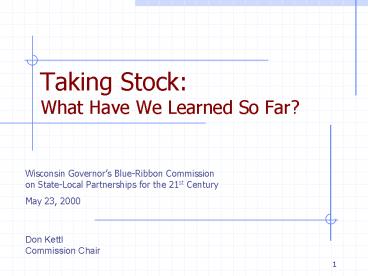Taking Stock: What Have We Learned So Far - PowerPoint PPT Presentation
1 / 26
Title:
Taking Stock: What Have We Learned So Far
Description:
Tailor web site to fit each citizen's needs: when to renew fishing license, ... Can we make government the model of the processes and themes in which we believe? ... – PowerPoint PPT presentation
Number of Views:33
Avg rating:3.0/5.0
Title: Taking Stock: What Have We Learned So Far
1
Taking StockWhat Have We Learned So Far?
- Wisconsin Governors Blue-Ribbon Commission
- on State-Local Partnerships for the 21st Century
- May 23, 2000
- Don Kettl
- Commission Chair
2
Big Picture
- Define our brand name
- Identify the problems we should solve
- Use the brand name to craft solutions
- Use the solutions to define roles, functions
- Use roles, functions to shape budget
3
1. Brand Name
4
Brand Name
- What should be the theme?
- What values should we promote?
5
Brand Name Options
- Put citizens at the center of government again
- One Wisconsin governments work together to serve
needs of citizens - Celebrateand updatethe Wisconsin tradition
6
2. Identify the Problems To Solve
7
What Problems Should We Solve?
- Values
- Preserveand updatethe Wisconsin Progressive
tradition - Economy
- Equip Wisconsin governments to build a 21st
century economy - Information technology
- Keep Wisconsin governments at the vanguard of
change - Citizenship
- Make citizens the center of governance again
- Transparency/simplicity
- Promote accountability by streamlining system
8
3. Solutions
9
Solutions Middle-Range
- Collaborative service delivery
- Information technology
- Citizens Charter
- E-governance
- Government as model
10
Collaborative Service Delivery
- Citizens want problems solved
- Citizens dont want to hear, Its not my job!
- No problem that matters stays within boundaries
11
Encouraging Collaboration
- Build problem-based approaches
- Create incentives for action
- Remove disincentives that discourage collaboration
12
Information Technology
- New challenges of information age
- On the Microsoft case . . . the White House
and Congress will soon be grappling with a new
political agenda stuffed with issues that many of
them dont really understand, and that arent
being discussed much in this years campaigns.
Speed, volatility, and indifference to national
borders are the key attributes of this growing
crop of New Economy issues. But Washington, with
its culture of consultation, deliberation,
special-interest paralysis and the pre-eminence
of nationhood, is poorly suited to resolving the
conflicts that are arising. - Wall Street Journal, May 1, 2000
13
Boundary Spanning
- IT gt virtual restructuring?
- Flexible, problem-based collaboration
- Different collaborations for different problems?
- Purchase of service arrangements
- Technology eases service-based collaboration?
14
Citizens Charter
- What services should Wisconsin citizens have the
right to expect? - How can they know that they receive high-quality
services at reasonable cost?
15
E-Governance
- Strategy single point of contact for citizens
- My California
- Web-based information keyed to key life events,
like auto registration, license renewal, traffic
fines, ratings of auto insurers - Virginia
- Tailor web site to fit each citizens needs
when to renew fishing license, drivers
licenseand transact business from home - Portal link to public and private sector
- Goal seamless collaboration
- Web-based procurement
- Goal smart government
16
Government as Model
- Can we make government the model of the processes
and themes in which we believe? - Remove statutory barriers to effective
performance - Create incentives for high-performance government
17
4. Roles and Functions
18
Options
- Redrawing boundaries
- Sorting out
- Performance
- Market basket
19
1. Redrawing Boundaries
- Horse-and-buggy government boundaries dont fit
the information age - Redraw boundaries to fit new realities
- Areas of shared resources (water
basins/ecosystems) - Areas of shared economic interest
- Areas of shared identity
- Citizens deserve local governmentbut pick one!
20
2. Sorting Out
- Determine which level of government ought to
perform which function, then - Government that spends the money raises the taxes
- Decentralize state tax sources to local
governments - or . . .
- Level tax capacity differences among local
governments - Centralize taxing, spending to state government
21
3. Performance
- Link state funding with local results
- Create performance partnerships to link state
aids with local results - Identify best practices
- Create financial incentives for high performance
22
4. Market-Basket Approach
- Badger Birthright
- Guarantee every citizen a collection of services
- State agrees to pay for these services
- Local governments have options to add to the
basket - Money follows citizens
- Alternative to giving money to governments or
bureaucracies
23
Market-Basket Options
- Supply-side
- Government provides the market basket (quality
education, clean environment, safe streets, . . .
) - Demand-side
- Government equalizes citizens ability to buy the
market basketthrough government or through
private, nonprofit sectors - Safety net
- State government ensures minimum service level to
indemnify citizens against accident of birth or
location
24
Options
25
5. Budget
26
Funding Flows
- Choose the options,
- shape the budget










![Fokas Beyond - Investing in the Stock Market The Smart Way [Part 6] PowerPoint PPT Presentation](https://s3.amazonaws.com/images.powershow.com/9728127.th0.jpg?_=20220228034)
![Investing in the Stock Market The Smart Way [Part 3] PowerPoint PPT Presentation](https://s3.amazonaws.com/images.powershow.com/9743107.th0.jpg?_=20220405076)
![Fokas Beyond - Investing in the Stock Market The Smart Way [Part 5] PowerPoint PPT Presentation](https://s3.amazonaws.com/images.powershow.com/9730432.th0.jpg?_=20220306022)


















